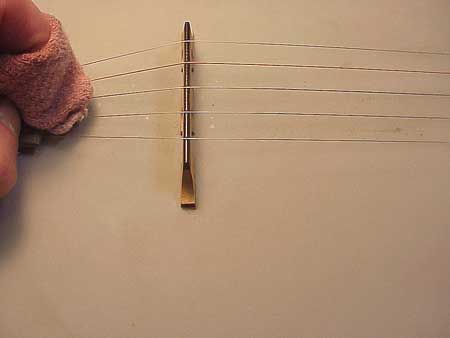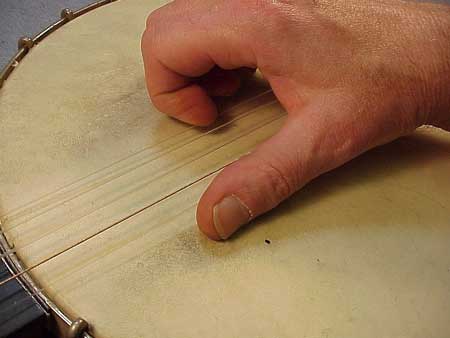It's all a matter of perspective
Cleaning Banjo Heads
© Frank Ford, 7/9/00; Photos by FF, 7/8/00
That's right. If you play traditional jazz on tenor banjo or plectrum banjo, you're
likely to look at this banjo head and think it's dirty:

Because, of course, it is dirty. If you play Irish string band music on a
tenor banjo, or if you play country, old time or bluegrass on a five string, you
may have a different opinion. You may argue that it has the "patina" of
wear and use. I've always thought that the difference in perspective had to do with
the fact that jazz is more urban. Probably, though, I'm overanalyzing as usual.
These days, virtually all banjo heads are Mylar plastic, often painted white.
To keep the dirt down, and to avoid the "scratchy" sound of dragging fingers
while strumming, tenor and plectrum players usually specify a banjo head that has
a shiny, impervious outer surface, with the white paint on the bottom, facing inside
of the instrument. Five string players need to be able to anchor their fingers on
the head without slipping around too much, so they prefer the rough white painted
surface on the outside.
This bluegrass banjo has a fair size dirt patch where the player rests two fingers
of the right hand:

Let's clean it up a bit.
Cleaning up a dirty plastic head is just as simple as it seems:

Squirt on a bit of cleaning fluid, and rub it off, just like a kitchen appliance.
See, it's pretty clean with just a wipe or two:

If left too long, the dirt will stain the paint, and be a bit more difficult to remove.
Here's a view of that special cleaning fluid:

I'll use Windex, 409, or whatever. If the dirt is really bad and the paint deeply
stained, just a TINY sprinkle of cleanser with chlorine bleach will power right through
it.
With increased wear and/or repeated cleaning, the paint will wear off, showing a
translucent patch of Mylar beneath:

There's no cure for missing paint except replacing the head, which, in itself, is
no big deal.
"Old time" banjo players often prefer the tone and appearance of natural
skin heads. As they play, they're constantly touching the head:

The patter of wear and dirt become quite clear:

You can't use a water based cleaner or cleanser on natural skin without damage, so
most of the time, this kind of dirt is left as a sign of "honest wear,"
indicating that the instrument is actually being used for its intended purpose.
This is the old timer's banjo head cleaning tool:

It's really a big soft eraser, a bit harder than an "Artgum." This particular
example is 75 years old and nearly petrified.
My favorite skin head cleaner is the ubiquitous "Pink Pearl" pencil eraser:

It takes a bit of scrubbing, but as you can see, some of the dirt cleans off reasonably.
If you're going to try to keep a skin head clean while the banjo is in daily use,
you'll be grinding up a lot of Pink Pearls. Left on, the dirt will stain the skin
deeply and not be removable at all. Any kind of oily stain will soak right in and
is permanent, too.
Personally, I go for that "patina" look. It's easier.
Back to Index Page









